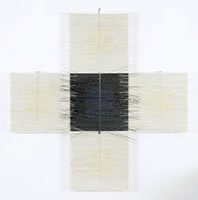
Blue and Yellow Cross (Cruz cobalto y limon)
1975
mixed media
154 x 154 cm / 60.6 x 60.6 inches

Small Blue Cube (Le petit Cube Bleu)
1962
mixed media
68.5 x 80 cm / 27 x 31.5 inches
|
|
|
|
Jesús Rafael Soto (1923-2005) adopted Kinetic art as his means of expression in the early 1950s following his move to Paris. His works not only examine the implied movement of Op art but also the actual movement Kinetic art provides. This is especially notable in his Penetrables series of the 1960s, interactive sculptures where the spectator is invited to get inside and walk through a space filled with dangling tubes of nylon .
Jesús Rafael Soto strove to create optical movement in his paintings and constructions. By the end of the 1950s he had developed an idiom in which squares, painted perspex or pieces of wire are placed in front of a background of thin parallel lines, causing the objects to vibrate visually with the movement of the viewer.
Early influences were cubism, Cezanne and Mondrian but it was not until Soto moved to Paris in 1950 and joined the circle of abstract artists associated with the Salon des Realites Nouvelles (Victor Vasarely for one), that he found his true calling in geometric art. Soto developed a Kinetic vocabulary with origins in serializations that produced optical vibrations.
Recent years have witnessed a renewed interest in optical art evidenced in exhibitions such as ‘The Expanded Eye’ at the Kunsthaus Zurich, Switzerland; 'Op Art' a the Schirn Kunsthalle Frankfurt, Germany; and 'Optic Nerve' at the Columbus Museum of Art, USA. Op artists, such as Soto and Vasarely, have been brought back to the forefront of today’s emerging art scene.
Soto had numerous solo shows around the world, most notably a major retrospective at the Guggenheim Museum, New York in 1974; the Galerie Nationale du Jeu de Paume, Paris in 1997; and most recently at the Museum of Latin American Art, California, 2005.
|